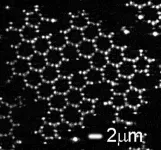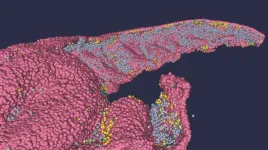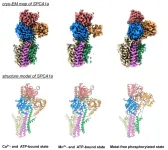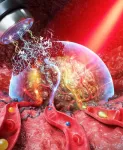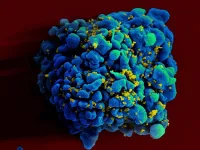(Press-News.org) An IIASA study shows that maternal education, and particularly secondary education, plays a significant role in reducing deaths in newborns and children under five years of age in both rural and urban areas of India.
Sustainable Development Goal (SDG) 3.2.1. aims to end preventable deaths of newborns and under-five children by 2030. Although significant progress has been made worldwide in this regard with global under-five deaths falling from 12.5 million in 1990 to 5 million in 2020, it is still a grave concern in many developing countries. This decline is primarily ascribed to improvements in the education of women, along with an increase in living standards and access to healthcare. How the educational attainment level of mothers affects the under-five mortality rate in rural and urban areas has however not been sufficiently explored until now.
In their study recently published in the journal Health & Place, IIASA researchers Moradhvaj and Samir K.C. for the first time explored the relationship between maternal education and children’s health in the rural-urban context in India. Their aim was to find out whether a mother’s educational attainment influences the under-five mortality rate between rural and urban areas in India, and how this has changed over the last three decades. (The under-five mortality rate is the probability of a child dying between birth and its fifth birthday).
“Understanding how education affects under-five mortality is crucial for understanding future population dynamics in developing countries,” notes K.C., who leads the Multidimensional Demographic Modeling Research Group of the IIASA Population and Just Societies Program.
In their study the researchers analyzed five rounds of the Indian National Family Health Survey (NFHS I-V) conducted between 1992 to 1993, and 2019 to 2021. The under-five mortality rate was calculated using data from a questionnaire, which collected detailed information about birth history data among women, especially the date of birth and survival status of each live birth, and the age at death of each deceased live birth. The questionnaire also provided additional information such as age, education, religion, caste, and reproductive behaviors. The data gathered was then fed into a hazard model to analyze predictors of under-five mortality.
The results show that under-five mortality remained higher in rural India across the five study surveys, which may be attributed to poor socioeconomic and healthcare conditions that prevailed there. However, after controlling for socioeconomic and maternal health predictors, the earlier surveys show a higher risk of under-five deaths in urban areas that have converged in recent years, resulting in no significant difference between rural and urban areas. Increasing maternal education, and especially secondary education, was found to reduce the risk of under-five deaths across the surveys.
“In recent years, there have been no significant differences in the under-five mortality rate of children born to mothers with an education level below- or at the primary level, but we know that in the past, the impact of maternal education on mortality differed between rural and urban areas. We found that women with a secondary education living in urban areas, experienced lower child mortality than their rural counterparts with a similar level of education. We did however not find the same effect in the most recent surveys,” explains Moradhvaj, a researcher in the same research group at IIASA.
The researchers conclude that, overall, maternal education, particularly secondary education, remained a protective factor for under-five mortality in both rural and urban areas, even after controlling for predictors.
“While current policies seem to be on the right track, it will be important to increase the educational opportunities in rural and urban areas with a particular focus on secondary education for girls to ensure that we keep up the decline in the under-five mortality rate in both rural and urban areas in India,” K.C. concludes.
Reference
Moradhvaj, M. & K.C., S. (2023). Differential impact of maternal education on under-five mortality in rural and urban India. Health & Place 80 p. 102987 [pure.iiasa.ac.at/18639]
About IIASA:
The International Institute for Applied Systems Analysis (IIASA) is an international scientific institute that conducts research into the critical issues of global environmental, economic, technological, and social change that we face in the twenty-first century. Our findings provide valuable options to policymakers to shape the future of our changing world. IIASA is independent and funded by prestigious research funding agencies in Africa, the Americas, Asia, and Europe. www.iiasa.ac.at
END
Increasing education opportunities for girls could help reduce preventable deaths in children under five
2023-03-24
ELSE PRESS RELEASES FROM THIS DATE:
Designing antennas for 6G V2X (Vehicle to Everything) communication
2023-03-24
Researchers at the Indian Institute of Science (IISc) are working on designing antennas that can empower 6G technology, which is instrumental in realising efficient V2X (Vehicle to Everything) communications.
In a recent study, the team, led by Debdeep Sarkar, Assistant Professor at the Department of Electrical Communication Engineering, shows how self-interference in full-duplex communication antennas can be reduced, and consequently the movement of signals across the communication network can be faster and more bandwidth-efficient. Such full-duplex ...
Pathogen mapped for the first time – to understand evolution and potential treatments
2023-03-24
A parasite which has devasting impacts on agriculture and human health is the first pathogen to have its proteins located and mapped within its cells – providing clues to their function and helping to identify potential drug targets.
African trypanosomes are parasites transmitted by tsetse flies that cause sleeping sickness in humans (presenting as fever, anaemia and, in serious cases, death) and a similar disease celled nagana in cattle. These parasites have made large areas of Africa unsuitable for ...
Graphene grows – and we can see it
2023-03-24
Graphene is the strongest of all materials. On top of that, it is exceptionally good at conducting heat and electrical currents, making it one of the most special and versatile materials we know. For all these reasons, the discovery of graphene was awarded the Nobel Prize in Physics in 2010. Yet, many properties of the material and its cousins are still poorly understood – for the simple reason that the atoms they are made up of are very difficult to observe. A team of researchers from the University of Amsterdam and New York University have now ...
Human Brain Project researchers develop new full-scale 3D structural model of the human hippocampus
2023-03-24
A new high resolution model of the CA1 region of the human hippocampus has been developed by the Institute of Biophysics of the Italian National Research Council (CNR-IBF) and University of Modena e Reggio Emilia (UNIMORE), part of the Human Brain Project. The single-cell resolution model, which replicates the structure and architecture of the area, along with the position and relative connectivity of the neurons, was developed from a full-scale dataset of high resolution images. The dataset is available in the BigBrain Atlas and it will be soon available on EBRAINS. According to the study, published in the journal ...
The first report on the incidence of moderate and severe OHSS in China
2023-03-24
Moderate and severe ovarian hyperstimulation syndrome (OHSS) developed in 1.14% of Chinese women of reproductive age between 2013 and 2017. Moreover, women under 35 years of age receiving assisted reproductive technology (ART) should be monitored for OHSS more closely compared with other age groups.
These findings were concluded from the first report on the incidence of moderate and severe OHSS in China recently published in Health Data Science, a Science Partner Journal.
OHSS constitutes the most severe iatrogenic ...
Cryo-electron microscopy captures structure of a protein pump
2023-03-24
Hailey-Hailey disease is a rare, inherited condition characterized by patches of blisters appearing mainly in the skin folds of the arm pits, groin and under the breasts. It is caused by a mutation in the gene that codes for a specific protein involved in the transportation of calcium and manganese ions from the cell cytoplasm and into a sac-like organelle called the Golgi apparatus. Scientists at Tohoku University, together with colleagues in Japan, have uncovered some aspects of this protein's structure that could help researchers understand how it works. The findings, published ...
AI “brain” created from core materials for OLED TVs
2023-03-24
ChatGPT's impact extends beyond the education sector and is causing significant changes in other areas. The AI language model is recognized for its ability to perform various tasks, including paper writing, translation, coding, and more, all through question-and-answer-based interactions. The AI system relies on deep learning, which requires extensive training to minimize errors, resulting in frequent data transfers between memory and processors. However, traditional digital computer systems' von Neumann architecture separates the storage and computation of information, resulting in increased ...
Contrast-enhancing agents to overcome physical and practical challenges of photoacoustic imaging
2023-03-24
A research team at POSTECH led by Professor Chulhong Kim (Department of Electrical Engineering, Department of Convergence IT Engineering, and Department of Mechanical Engineering) has compiled the findings from innovative research on contrast-enhanced photoacoustic imaging conducted over the last four years. These findings were recently featured in Chemical Reviews, a highly authoritative journal.
For decades, the scientific community has been investigating the potential of photoacoustic imaging as a biomedical imaging modality. However, despite its enhanced optical contrast and ultrasonic spatiotemporal resolution, photoacoustic imaging faces ...
A readily available dietary supplement may reverse organ damage caused by HIV and antiretroviral therapy
2023-03-24
FINDINGS
MitoQ, a mitochondrial antioxidant that is available to the public as a diet supplement, was found in a mouse study to reverse the detrimental effects that HIV and antiretroviral therapy (ART) have on mitochondria in the brain, heart, aorta, lungs, kidney and liver.
The researchers used a molecular method to measure the ratio of human and murine mitochondrial (mtDNA) to nuclear DNA (ntDNA) ratio, a measure of mitochondrial dysfunction. Reduction in this ratio reflects mitochondrial dysfunction. Compared to uninfected mice, HIV infected mice treated with ART had mitochondrial dysfunction in the human immune cells in the brain, ...
New research project aims to set standardized approach to lipoprotein(a) management
2023-03-24
DALLAS, March 24, 2023 — High levels of lipoprotein(a) [Lp(a)] are an independent, predominantly inherited and causal risk factor for cardiovascular disease, the leading cause of death and disability worldwide, according to a recent American Heart Association scientific statement. It is estimated that 1 in 5 Americans have high Lp(a) levels. Studies have shown that elevated Lp(a) — a low-density lipoprotein variant containing a protein called apolipoprotein(a) — is a risk factor for atherosclerosis (buildup of fatty material in artery walls) and related ...

